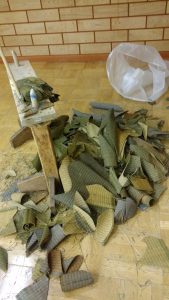「獺祭」と「据え物斬り」の稽古跡/“獺祭(Dassai, Sake Brand) and a mark after Suemono-giri exercise
本日(4/26)の居合の稽古は袈裟斬りで巻き藁を6本斬ってから、その斬りカスを使って苦手の据え物斬りを行います。
Today’s Iai training is Kesa-giri (slanting cut down) for 6 Makiwara (bundle of straw tubes) and Suemono-giri (vertical downward cut) using remaining of Kesa-giri.
(English text continue to the latter half of the page)

まずは袈裟斬りをひとしきり。

いずれの巻き藁も比較的いい角度で斬れています。

道具に板を渡した上に巻き藁を積み上げ真上から垂直に斬り下ろすのが据え物斬り。さんざん稽古した跡がこれ。実に見事にとり散らかっています。
「獺祭(だっさい)」という有名な日本酒があります。「獺祭」と言う言葉は「カワウソの祭り」という意味。これは中国の故事で、カワウソの巣の中で捕まえた魚を食い散らかして散らかった様を、勉強家が本や資料を渉猟する様子に見立てて“努力する勉強家”の表現に用いられたもの。つい据え物斬りの稽古の跡をみてこんな話を思い出してしまいました。
Today’s Iai training is Kesa-giri (slanting cut down) for 6 Makiwara (bundle of straw tubes) and Suemono-giri (vertical downward cut) using remaining of Kesa-giri.

First I cut 6 Makiwaras by Kesa-giri.

Each piece of Makiwara shows good angle section.

I exercised Suemono-giri toward pieces of Makiwara piled up on the board. After the exercise it looks like this. It looks so messy!
There is a famous brand Sake, named “獺祭(Dassai)”. “Dassai” means “Feast of otter”. Inside of otter’s nest is cluttered with fishes. A Chinese anecdote resembles this scene as the study room of diligent student with full of books. This messy scene reminded me of the anecdote.
